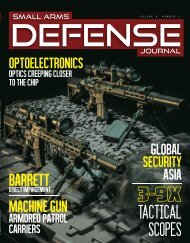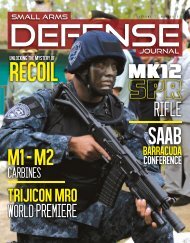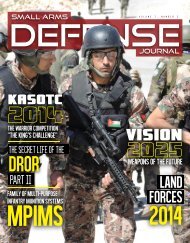SAR 18#6
You also want an ePaper? Increase the reach of your titles
YUMPU automatically turns print PDFs into web optimized ePapers that Google loves.
The final wz.38M SLR is a semiautomatic,<br />
gas-operated weapon with<br />
a tilt-locked bolt, fed from a 10-round<br />
fixed internal magazine. The rifle had<br />
68 parts, which was quite reasonable<br />
against the background of the contemporary<br />
designs: the SVT-38 numbered<br />
63, the G41(W) 66, but the M1 Garand<br />
only 55. For cleaning it can be broken<br />
down into just four components: barreled<br />
action with buttstock, gas cylinder,<br />
bolt carrier with return spring and bolt.<br />
This was not the end of the road<br />
neither for the Maroszek rifle, nor for the<br />
SLR for the Polish Army. The contest<br />
was still hot, the Szteke’s kb.sp. wz.37S<br />
(former ES) was also still under development<br />
and tested in November 1938,<br />
where during the durability testing it still<br />
did not reached the goal of 10,000 shots,<br />
having failed (receiver hairline crack discovered)<br />
after 8,000. This was the final<br />
failure, but earlier on the 37S chewed<br />
through three firing pins (after 300, 550<br />
and 1,800 shots), extractor (859 shots),<br />
and bolt bumper (4,923 shots). Despite<br />
all that the project continued with new,<br />
improved 3rd Gen prototypes ordered<br />
for further testing in 1939. On 26 February<br />
1939 one each ‘enhanced accuracy’<br />
wz.37S and wz.38M rifles were ordered<br />
for a shoot-off to determine which rifle<br />
would serve as a basis for a sniping rifle.<br />
This is unfortunately the last paper trace<br />
left by either of the rifles.<br />
As the delivery deadline for the 55<br />
rifles was 1 January, 1939, and no trace<br />
of any further barrel orders was found<br />
so far, it is safe to assume that not more<br />
than that number of the wz.38M rifles<br />
were ever manufactured. All serial numbers<br />
known so far are contained within<br />
the 1001 – 1055 range, corroborating<br />
the quantity.<br />
Maroszek Redux<br />
This author had the opportunity to<br />
handle, strip and examine in detail the<br />
Maroszek rifle, s/n 1048 that was owned<br />
by Bob Farris in the U.S. but unfortunately<br />
firing it was not possible as it had<br />
a familiar Maroszek ailment: the firing<br />
pin point was broke off. Regardless, it<br />
was different from the one we had in Poland<br />
– with just one cross-bolt, instead<br />
of two. Later on, two other Maroszeks<br />
were found in America, both of a single<br />
cross-bolt variety, while another twobolt<br />
rifle was found in Germany. With<br />
no hard documents to prove it, one can<br />
only assume that this might have been a<br />
last-minute addition, perhaps a result of<br />
the spring of ‘39 troop-testing, perhaps<br />
to reduce the lower receiver wobble. So,<br />
perhaps the 1014 and 1027 were prototypes<br />
for the new series-production<br />
model? How significant, that one ended<br />
up in Germany, and the other in Russia<br />
– two hoodlums conspiring against<br />
Poland in 1939... We’ll never know.<br />
Or do we? Once at the Museum,<br />
I met a gunsmith from Piotrowo near<br />
Poznan, Mr. Ryszard Tobys, whom I<br />
knew as the Guinness’ Book of Records<br />
world’s largest cap-and-ball revolver<br />
manufacturer. He was planning to build<br />
a shooting replica of the Maroszek rifle.<br />
Technical Data<br />
Caliber: 8mm x 57 JS<br />
Length: 1,134 mm<br />
Barrel length: 625 mm<br />
Weight:<br />
Magazine capacity:<br />
Method of operation:<br />
Locking method:<br />
4.45 kg<br />
10 rounds<br />
wz.38M<br />
He was taking some measurements to<br />
reverse engineer some small bits, which<br />
in reality looked quite different from the<br />
blueprint. It transpired that Mr. Maroszek’s<br />
nephew in Białystok inherited a<br />
set of production blueprints for the wz.<br />
M rifle. This was the penultimate version<br />
of it – those five prototypes of 1937, so<br />
several changes were introduced later,<br />
which he was then analyzing comparing<br />
blueprints with the real thing.<br />
In November 2013 rifle s/n RT001<br />
was ready, and I’ve been the first journalist<br />
to see it, handle it, and shoot it.<br />
The first rifle was more of a test-bed<br />
than show-piece, but I’ve seen three<br />
barreled actions in various stages of<br />
manufacture, so there would be better<br />
and prettier ones once all the bugs<br />
are ironed out of the first. The price tag<br />
would be enormous as the project already<br />
cost thousands upon thousands<br />
of hours of hard work, but fortunately<br />
Ryszard’s two sons, Błażej and Remigiusz<br />
can program his CNC machines<br />
for free, so he can avoid the most costly<br />
part. At first, the components were machined<br />
in aluminum and brass to check<br />
if they fit together, then real parts were<br />
made and fitted. This seems to be a<br />
really nice, well balanced, and smooth<br />
to shoot rifle – given it’s chambered in<br />
8mm x 57JS Mauser.<br />
Gas-operated with piston<br />
Bolt tilting into ejection opening (Browning-Petter)<br />
www.gunmountain.com<br />
www.smallarmsreview.com 81 <strong>SAR</strong> Vol. 18, No. 6









